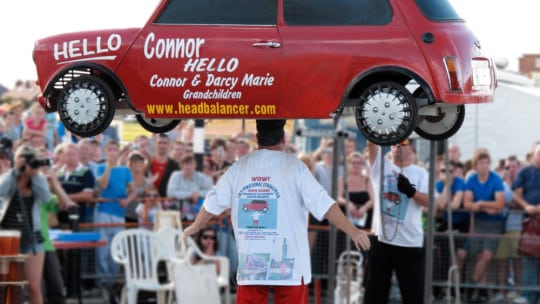
Many PR pros are turning to visual storytelling in this time of shortened attention spans and video dominance, but some have found it useful to take the concept a step further, envisioning their brands as entertainment channels. Guinness World Records, which some of us may remember flipping through in hardcover form as children, has grown its digital arm in recent years, and has set to work pairing its absorbing content with other brands in creative and unexpected ways.
For instance: When LG partnered with Guinness World Records to help generate excitement around the launch of a new laundry machine in May 2016, LG enlisted a professional card-stacker to build the tallest card tower ever constructed in 12 hours. The resulting video, which has been viewed over 175,000 times on YouTube, succeeded in creating an air of high drama around an everyday household item. In a separate campaign, Mike's Hard Lemonade broke the record for most candles on a birthday cake on its 17th anniversary, lighting a candle for every Facebook like it received over the course of the campaign.
At the 2016 PRSA International Conference, Keith Green, vice president of marketing and commercial sales at Guinness World Records, and Doug Simon, president and CEO, D S Simon Media, spoke on the nature and evolution of brands as sources of video entertainment. PR News sat down with them after their session to learn how communicators can benefit from taking an entertainment-style approach with their channels and pitches.
PR News: How do brands partner with Guinness World Records? What's that process like?
Keith Green: Sometimes they come directly to us, knowing exactly what Guinness World Record title they'd like to break or set; other times, they have no idea at all and need our creative input to help them come up with something. Other times they'll come to us with an idea that doesn't quite fit into the criteria we have for a record, and we'll come back to them [with a] different approach.
PR News: What are some creative ways you brainstorm with brands that aren't sure what records they want to attempt?
Green: We tell our potential clients: Don't think about the event as a moment in time; think about the story leading into it and something that's more of an [extended] campaign and not just a one-off. You can highlight a product attribute in a different way [to produce] a tremendous campaign.
PR News: What do communicators get out of presenting their brand as an entertainment medium?
Doug Simon: The key is to have different channels of content that you're delivering to different, specific audiences that are designed to enhance what your organization is hoping to communicate and achieve.
PR News: How can "dry" brands, like a highly technical b2b, for instance, get buy-in from senior leadership to think like an entertainment brand and move more into video content?
Simon: For a b2b brand, it's even more important than a b2c brand, because the upside is so strong—so few of the companies in that space are thinking that way. The number one thing you can do is engage your prospects and influencers in the content themselves. By interviewing [attendees] at a trade show, we gave a tech company their own platform to engage their audience. Coca-Cola has turned their website into a journal, a media outlet. That's where [b2c] brands are going. But as a b2b brand there's great opportunity, because there are so few others who are doing it that you can easily establish yourself as a thought leader based on participation and engagement.
PR News: If you're a PR pro sending a pitch that incorporates video, would you advise structuring that pitch as a traditional one with a video tacked on, or should you keep the text to a minimum?
Simon: I would take it on a case-by-case basis. Some journalists won't get past what's in a subject line in an email, so you have to think strategically about the subject line that's going to get them to look further.
A lot of it has to do with the relationship—do you have a relationship with them already? A significant number of journalists will take pitches via social media. One of the best pitches I've found that works—assuming you have the appropriate relationship to do so—is, "How'd your daughter do in her softball game?" [Or:] "Hey, thought you might be intrigued by this, would love to get your feedback." I call it a non-pitch pitch.
A great use of video is to let [journalists] know you've got a spokesperson who's good on camera. "Hey, saw you've been covering ___; our person has appeared on ___ speaking on related issues. If you need them for a story, we can turn them out for you 24/7." That's what establishes credibility and standard.
PR News: What are some of the best brand campaigns you've seen in visual media in the past few years?
Simon: Under Armour ran a very funny campaign a few years ago featuring Tom Brady of the Patriots about his New England accent. There was [a humorous video we made] that ended up on TMZ (above); a football player milking a cow. It used to be called a "man-bites-dog" story, where you're approaching stories in an unexpected way that served the brand attributes.
Green: There's the Mike's Hard Lemonade example, where you're trying to engage people in an indirect way around a product, rather than hitting them over the head with a message. It's a call-to-action: Give us a like on Facebook and for every like we get, we'll add a candle. They created a tremendous video around the cake: 50,000 candles, lighting it with blowtorches, extinguishing it, and, yes, even eating it afterwards!
Follow Keith: @KeithsTweets
Follow Doug: @DSSimonDoug
Follow Sophie: @SophieMaerowitz
